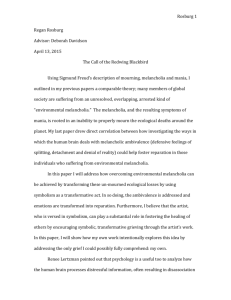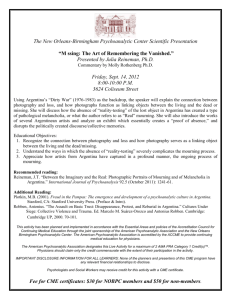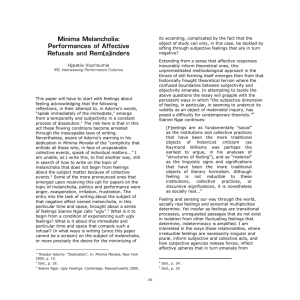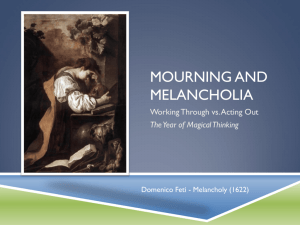SP15 Paper 1 - WordPress.com
advertisement
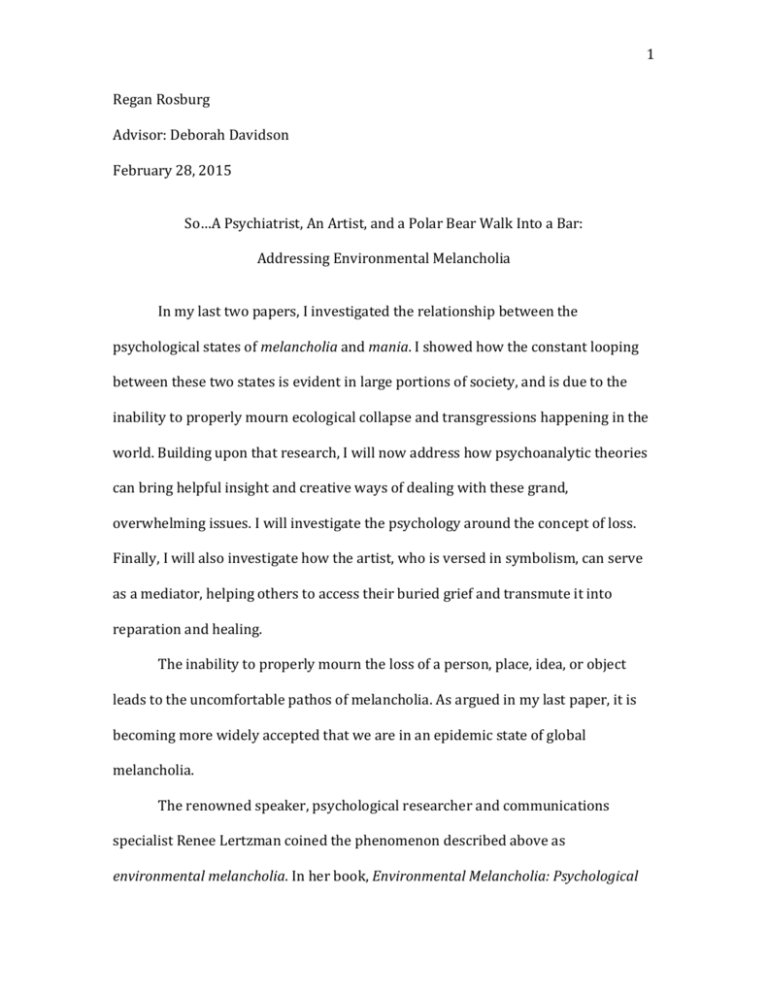
1 Regan Rosburg Advisor: Deborah Davidson February 28, 2015 So…A Psychiatrist, An Artist, and a Polar Bear Walk Into a Bar: Addressing Environmental Melancholia In my last two papers, I investigated the relationship between the psychological states of melancholia and mania. I showed how the constant looping between these two states is evident in large portions of society, and is due to the inability to properly mourn ecological collapse and transgressions happening in the world. Building upon that research, I will now address how psychoanalytic theories can bring helpful insight and creative ways of dealing with these grand, overwhelming issues. I will investigate the psychology around the concept of loss. Finally, I will also investigate how the artist, who is versed in symbolism, can serve as a mediator, helping others to access their buried grief and transmute it into reparation and healing. The inability to properly mourn the loss of a person, place, idea, or object leads to the uncomfortable pathos of melancholia. As argued in my last paper, it is becoming more widely accepted that we are in an epidemic state of global melancholia. The renowned speaker, psychological researcher and communications specialist Renee Lertzman coined the phenomenon described above as environmental melancholia. In her book, Environmental Melancholia: Psychological 2 Dimensions of Engagement, she states that environmental melancholia is partially caused when loss and mourning are unattended to. What is more, she addresses the seeming paradoxical response of inaction from those who claim to care deeply about the environment. She says, “Even those who care deeply about the well-being of ecosystems and future generations are paralyzed to translate such concern into action” (12). She also says that there is a definitive, psychological correlation between the inability to reconcile loss or ambivalent feelings and the onset of manic defense mechanisms such as denial, defensiveness, guilt, avoidance, and splitting.1 These findings indicate that psychoanalytic study can be used to provide powerful insight into the unconscious responses to overwhelming environmental degradation situations, as well as ingrained strategies for how the brain will defend itself, avoid painful situations, and process anxiety.2 As Lertzman points out, “One of most notable and significant attributes of psychoanalytic work as it pertains to ecological crisis is the recognition of how unconscious processes drive our individual and social behaviors” (3). Loss and Restoration: From the Mouths of Babes The heart of these unconscious processes, and the seed of ambivalent feelings, can be attributed to how the mind subconsciously deals with the concept of loss and restoration. This begins in the early stages of development. Melanie Klein describes this phase in infants when the child’s object relations undergo a 1 In my last paper, “Paradox City,” I outlined how these defense mechanisms fall under the category of “manic responses” or “mania,” which is the second half of the destructive, dysfunctional loop (Rosburg 2–8,). 2 In fact, in 1992, the Freud Museum in London housed a meeting of psychoanalysists and environmental activists to discuss how people were responding to ecological threats (Lertzman 119). To these seemingly different groups of people, both of whom focus on reparation as their ultimate goal, it would seem that common ground was that the loop of melancholia–mania, anxiety–disengagement, and avoidance–overconsumption was not a question of “if,” but of “why.” 3 fundamental change, called the “depressive position” (Segal 392). It happens when the child recognizes her mother or father as something not only outside of herself, but also as not just good or bad. The child realizes that the object is a whole object, and when anger or aggression arises against the parent, the child is able to remember the positive aspect of the parent, and consequently does not wish to invoke harm. The child feels guilt for harboring angry feelings. This is the first experience the child has of loss and restoration. At its core, the lesson of this phase of life is the ability to tolerate ambivalent feelings, or even completely opposing feelings at the same time. A sense of inner reality is developed (392). Even though the manic defenses (denial, splitting, idealization, and projective identification) are still present, the child is able to hold the ambivalence of also loving his parent. Thus, the child’s “growing love, strength and skill gives him increasing confidence in his own capacities to restore” (392) and the child is able to relinquish the defenses. What occurs is the desire to create reparation. The key to reparation is acknowledging the loss and ambivalence. In fact, Segal states that “It is only when the loss has been acknowledged and the mourning experienced that recreation3 [i.e.: reparation or restoration] can take place” (393). The Role of Ambivalence: Embrace Your Dark Side How is it that one can deal with objects of loss as grandiose or abstract as a dying ecosystem, or a melting glacier, or a polluted waterway, while at the same time desire cheap gas, long showers, and shopping centers? As Lertzman points out, “we are able to simultaneously hold conflicting desires, thoughts and impulses, even 3 The meaning of re-creation in this sentence is reparation or restoration. 4 those that are diametrically opposed (120). In other words, ambivalence is often present. Lertzman studied everyday people near the Great Lakes region, focusing on participants who were caring towards the environment but not necessarily active in their efforts to advocate change. She found that many participants had conflicting feelings towards the Great Lakes; the lakes provided industry, and thus supported the economy, yet at the same time were polluted and disintegrating before their very eyes. They were experiencing feelings of anxiety, loss, and fear along with the pride. Above all, they were feeling guilt for not actively advocating a halt to the pollution. However, to rally against the polluter would be to bite the hand that feeds them. Narratives of loss and sadness, a kind of “arrested mourning,” struck Lertzman (122). Despite the existence of these feelings, there was also a detectible detachment in the way the participants spoke of the sites. “It was with nostalgia,” Lertzman said, “as if the site itself no longer existed” (122). Furthermore, these objects of environmental loss “were facing chronic threats” and yet, they not only ceased to be alive and active for the participants, but also were “held in a static, idealized state” (122). In other words, Lerztman’s study showed that the participant’s ambivalence towards these lost objects was not acknowledged. As a result, she noted how melancholia had set in, and with it came the manic defense mechanisms of detachment, denial, and a lack of reality. 5 Lertzman skillfully argues that the ambivalent feelings people experience cause inaction out of fear and denial, and that this inaction is misconstrued as public apathy. In her research she has found “high levels of concern – sadness, anxiety, grief, and loss” (122) and that it definitely did not signify a lack of emotion, as indicated by the word apathy. She has gone so far as to call public apathy a myth (122), and seeks to use psychological insights as a way for the public to have creative spaces in which to discuss their buried emotions and concerns. Symbolism: The Way In is the Way Out With the recognition of loss comes the ego’s desire to recreate the object outside of ones self, consciously or unconsciously, as a symbol4. This aids in processing the loss. In Segal’s A Pyscho-Analytical Approach to Aesthetics, she says, “symbol formation is the outcome of a loss, it is the creative act involving the pain and the whole work of mourning” (203). In creating a symbolic object or act,5 the symbolized objects or ideas can be addressed gradually, and healthfully processed by the ego. It would stand to reason, then, that with the loss of species, habitat, and the certainty of things like clean water and normal weather patterns, there is a need to form a symbol or symbolic act in order to process the loss. Yet there is more than physicality going on. When the desire for something has to be given up or repressed, it must be represented symbolically (202). So it is not just the loss of the actual, 4 Symbol formation is the ego’s attempt at dealing with anxiety that has been formed around the original object (Segal 392). 5 An example of a symbolic act would be a funeral, for example, or the burning of letters written to a deceased person or ex-lover. 6 physical spaces and species that are in need of symbolizing, it is also the repressed desire for a change in conditions that needs to be symbolized. There are many people that are able to symbolize and process their grief through object making, abstract symbol formation, or symbolic acts. Planting a garden, buying organic produce, riding bicycles, and having discussions with friends and strangers are a few examples. However, as outlined in my previous papers on the looping flow between melancholia and mania, there is evidence that the option of choosing distraction and consumption in order to avoid or numb the melancholic, unprocessed loss can sometimes be far more inviting and socially acceptable. The symbols that proliferate daily life are consumable objects and advertisements for goods and services that can promise gratification on a superficial level. However, the creative strength of artists could aid in a healthy processing through their intuitive grasp of symbol formation. An artist possesses the resilient quality of manufacturing symbols that can represent a concept of ruin (Segal 199). They also have an acute sense of inner reality as well as the reality of their materials (203). This may be an untapped resource to allow for the general public to identify with symbols of loss. In the words of Sigmund Freud, “What the artist aims at is to awaken in us the same mental constellation as that which in him produced the impetus to create” (204). If the artist can tap into a sense of grief and loss about these issues, it could help members of society who struggle with the same issues. 7 Works Cited Freud, Sigmund. On the History of the Psycho-Analytic Movement: Papers on Metapsychology and Other Works. Trans. James Strachey, Anna Freud, Alix Strachey and Alan Tyson. London: The Hogarth Press. 243-258. Print. Lertzman, Renee A. Environmental Melancholia: Psychological Dimensions of Engagement. Unpublished Book. Expected Print Date: June 2015. Lertzman, Renee A. "The Myth of Apathy." Ed. Sally Weintrobe. Engaging with Climate Change: Psychoanalytic and Interdisciplinary Perspectives. New York: Routledge, 2013. 117-33. Print. Segal, Hanah. "Notes on Symbol Formation." The International Journal of Psychoanalysis 38 (1957): 391-397. Web. Segal, Hanah. "A Psycho-Analytical Approach to Aesthetics." The International Journal of Psychoanalysis 33 (1952): 196-207. Web. Rosburg, Regan. The Death of Everything: An Epidemic of Global Melancholia. Unpublished Essay, Lesley University College of Art and Design. 2014.
